This post may contain affiliate links. Please read our disclosure policy.
A silky, flavorful squash soup recipe using a combination of roasted squash, fresh herbs, onion and garlic. This is my favorite easy, healthy vegan lunch or dinner!

A Quick Look at The Recipe
- Prep Time: 15 minutes
- Cook Time: 40 minutes
- Total Time: 55 minutes
- Servings: 6 bowls
- Calories: ~120 kcal (based on nutrition panel)
- Technique: Roast squash, sauté aromatics, blend with stock.
- Flavor Profile: Silky, herb-forward, naturally a tad sweet.
- Difficulty: Easy, beginner-friendly.
Why You Will Love This
- Bold, cozy flavor from two squash varieties. Butternut adds sweetness, while kabocha or Blue Hubbard brings silkiness and depth. Together they create a complex soup from simple ingredients!
- Velvety-smooth texture every time. Between careful roasting, blending with stock gradually, and peeling squash when hot, this method guarantees the kind of silkiness you’d expect in a restaurant soup.
- The mix of fresh herbs is part of what makes it the best! Some versions rely on heavy cream, but I prefer letting herbs and a crunchy garnish do the work.
Featured Comment
⭐⭐⭐⭐⭐ This soup was incredible! The note about fresh produce was so helpful because the squashes near me are almost the size of housecats, so knowing how to adjust the roasting time really made a difference. I couldn’t believe how creamy this turned out for a vegan recipe. Definitely adding this one to my fall rotation! —Lauren
Table of Contents
- A Quick Look at The Recipe
- Why You Will Love This
- Ingredients & Substitutions
- How to choose a butternut squash for soup
- Variations for Creamy Butternut Squash Soup
- Professional Tips
- How to Make Squash Soup
- How to roast butternut squash for soup:
- How to roast kabocha or Blue Hubbard squash for soup:
- How to Make Roasted Squash Soup:
- How to make roasted pepitas:
- Chef Lindsey’s Recipe Tip
- Recipe FAQs
- Recommended Squash Recipes
- Squash Soup Recipe
- Before You Go
I make this soup or a variation of it several times a month all winter long because it’s that cozy, that silky, and that reliable. Roasting the squash brings out a natural sweetness, while fresh herbs make the flavor deep and comforting.
This recipe works beautifully with roasted squash or even canned butternut puree if you’re short on time! Top each bowl with spiced pepitas, a swirl of olive oil, or homemade croutons for contrast.
If you’re looking for more winter comfort, you might also love my lamb stew recipe, quinoa vegetarian meatballs, or red chili with ground beef.
Ingredients & Substitutions
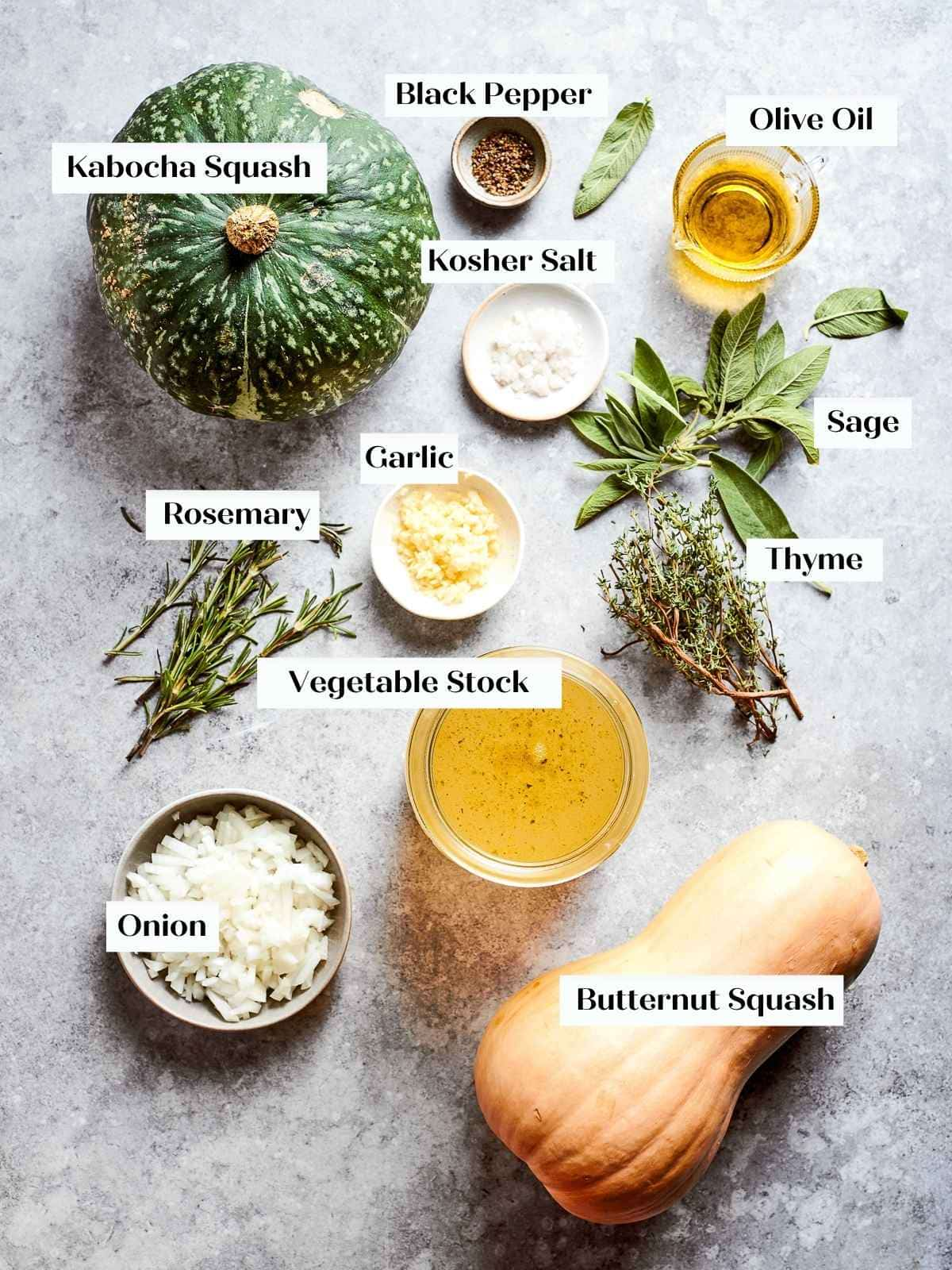
- Vegetable Stock or Vegetable Broth
- Kosher Salt: I like to use kosher salt in my cooking because it is less salty per teaspoon than other types of salt.
- Butternut Squash
- Onions: Sweet, white, and yellow onions will work for this recipe, but I most commonly use yellow onions and sweet onions. Those are also my favorite onions to use in my Best French Onion Soup!
- Garlic
- Olive Oil: Olive oil is used to sauté the aromatics before adding the broth and other ingredients. You could use avocado oil here as well.
- Black Pepper
- Roasted kabocha squash, or Blue Hubbard
- Fresh sage, thyme, and rosemary: Cooking woody herbs like rosemary and sage in oil pulls out and intensifies their flavors, which can otherwise be lost in a dish like soup. You could use dried herbs. I would still add the dried herbs with the garlic and onion to try to soften and coax out as much flavor as possible.
- Pepitas: The spiced pepitas are optional but who doesn’t love a little crunch. You could also roll with croutons. Maybe made from leftover pumpkin dinner rolls or pumpkin challah!
See the recipe card for full information on ingredients and quantities.
How to choose a butternut squash for soup
- Standardizing a recipe that uses fresh produce is more challenging than those using canned due to the large variation in size! The important thing to know is that it doesn’t matter. I have written the recipe in cups (4 cups = 1 quart) to lend some level of standardization, but you can use a larger squash without fear. Just be sure to adjust the seasoning as needed.
- For example, you might choose a slightly larger onion and use a rounded tablespoon of minced garlic for a larger squash. Add a few more herbs or don’t, and be aware you might need more stock to thin out the soup.
- When picking a butternut squash, choose one that does not have any green and feels heavy for its size. Pick up a few, and make a batch of vegan chili next!
Variations for Creamy Butternut Squash Soup
- Incorporate different veggies. You can swap in parsnips, russet potatoes, or sweet potatoes.
- Add an apple! Adding a tart apple, like a Granny Smith, when you add the squash will give you a sweet-tangy lift that’s especially fun in autumn.
- Could you use your freshly separated seeds to make the topping? Yes, but who has the time for that? Pepitas are just the soft seed within the casing and are much more palatable anyways.

Professional Tips
- Roast for flavor, not just softness. Roasting the squash cut-side down develops caramelization on the edges. This deepens sweetness and prevents watery soup!
- Best to peel the squash. Technically the skin is edible and soft when baked covered and I do not peel before serving, but I do peel it before using in soup or making puree. I do find it easier to remove the skin when it is hot but it is still very easy to do once cold.
- Add the stock in stages as you blend. This keeps the soup thick and creamy instead of accidentally thinning it too much.
How to Make Squash Soup
Use these instructions to make the perfect squash soup every time! Further details and measurements can be found in the recipe card below.
How to roast butternut squash for soup:
Step 1: Preheat the oven to 350°F.
I choose to slow roast the butternut rather than roasting at a higher temperature to allow for a little caramelization. It’s optional. Do what you need to do!
Step 2: Cut the top and bottom off the butternut squash with a large chef’s knife. Stand the squash upright on the bottom – you just cut a nice flat surface, which will make a solid base to slice the squash in half. Use the chef’s knife to cut the squash in half lengthwise, pushing down from the top of the knife, keeping your fingers clear of the blade!
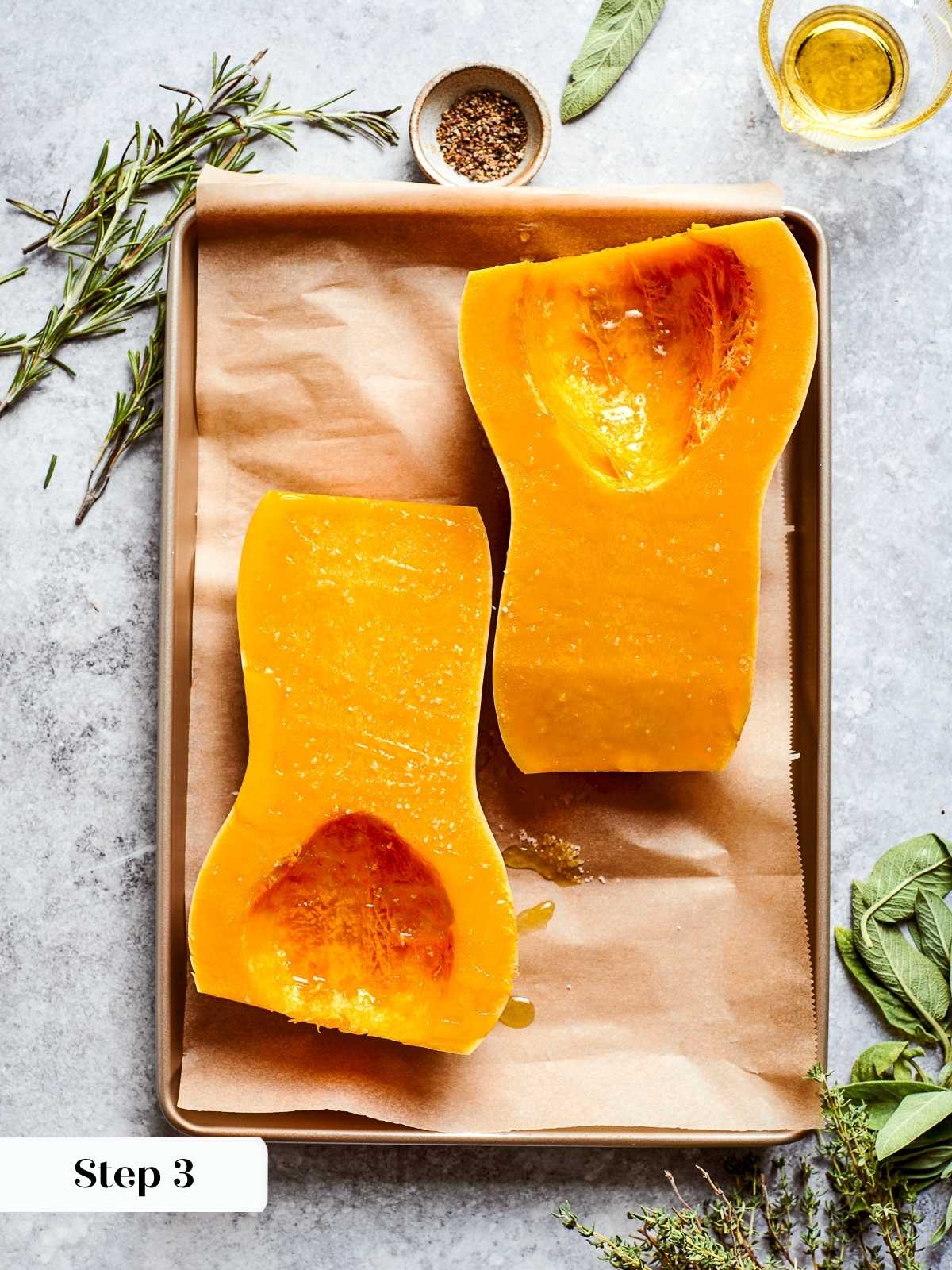
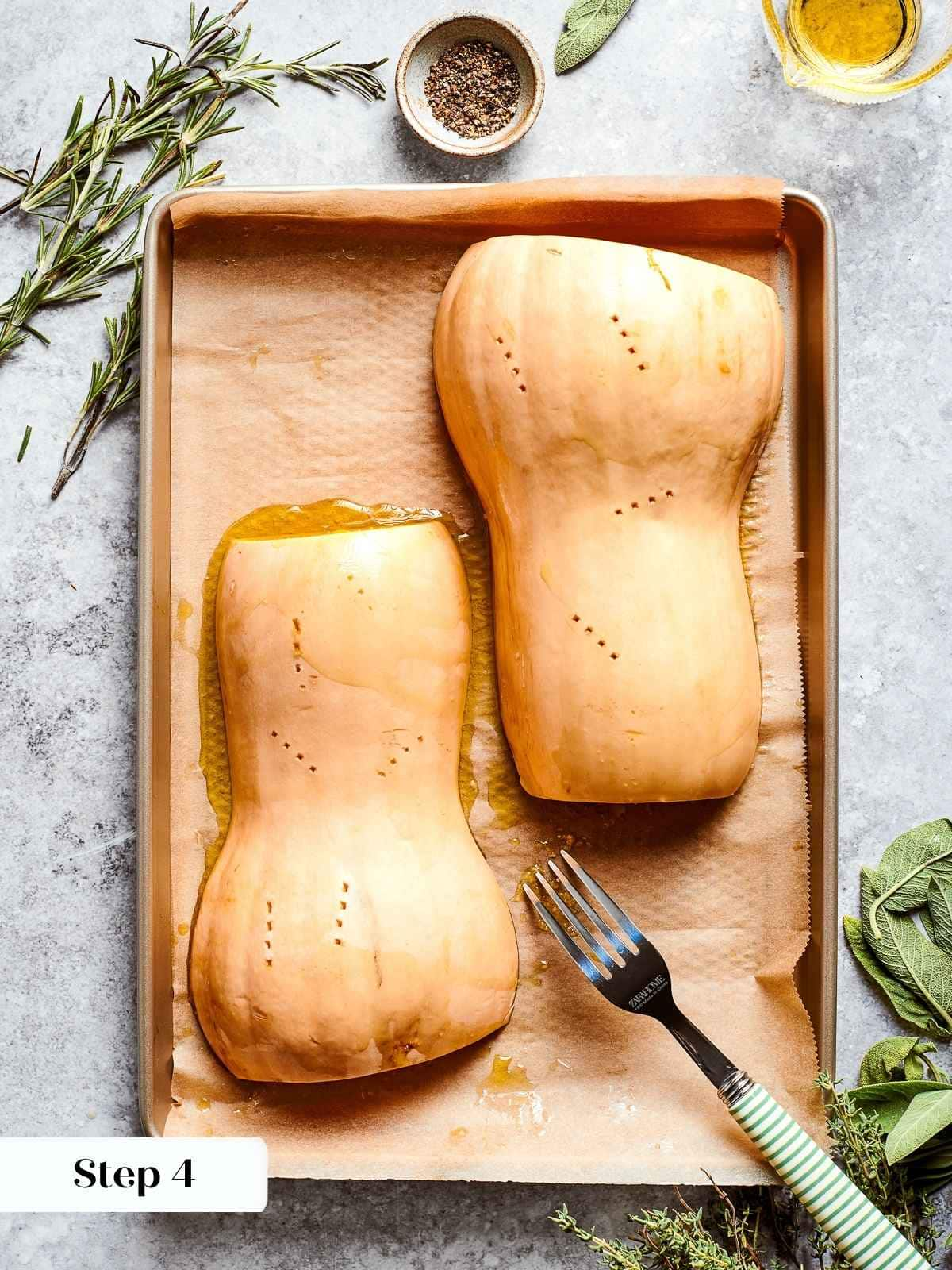
Step 3: Scoop out the seeds and either throw them out or set them aside to clean and roast (photo 1).
Step 4: Prepare the baking sheet. Line a baking sheet with a piece of parchment paper and place the squash cut side up on the baking pan. Drizzle with olive oil and sprinkle with kosher salt. Flip them over, cut side down. Poke some holes using a fork or the tip of your knife (carefully!) up and down the length of the squash (photo 2).
Step 5: Roast until tender. Place it in the oven and bake until they are soft when pressed with your finger or provide no resistance with a paring knife. The roasting time will vary greatly by the size of your squash! Expect anywhere from 25 – 40 minutes.
Step 6: Scoop all the soft, roasted butternut squash flesh from the skins and set aside or cool and store in an airtight container in the refrigerator.
How to roast kabocha or Blue Hubbard squash for soup:
Step 7: Preheat the oven to 350°F.
Step 8: Cut the top and bottom off the kabocha squash with a large chef’s knife. Stand the squash upright on the bottom – you just cut a nice flat surface, which will make a solid base to slice the squash in half. Use the chef’s knife to cut the squash in half lengthwise, pushing down from the top of the knife, keeping your fingers clear of the blade! Kabocha have thick rinds, so this might take some force; you can also pick the whole thing up and bang it down on the cutting board while keeping your fingers clear of the knife blade!
Honestly, a cleaver would be a better tool, but I don’t have one. If your grocery store sells them by the half, consider it a blessing straight from God to your kitchen and pick one up! Or 2 because paying a little more is worth saving the effort! Trust me.
Step 9: Scoop out the seeds and either throw them out or set them aside to clean and roast.
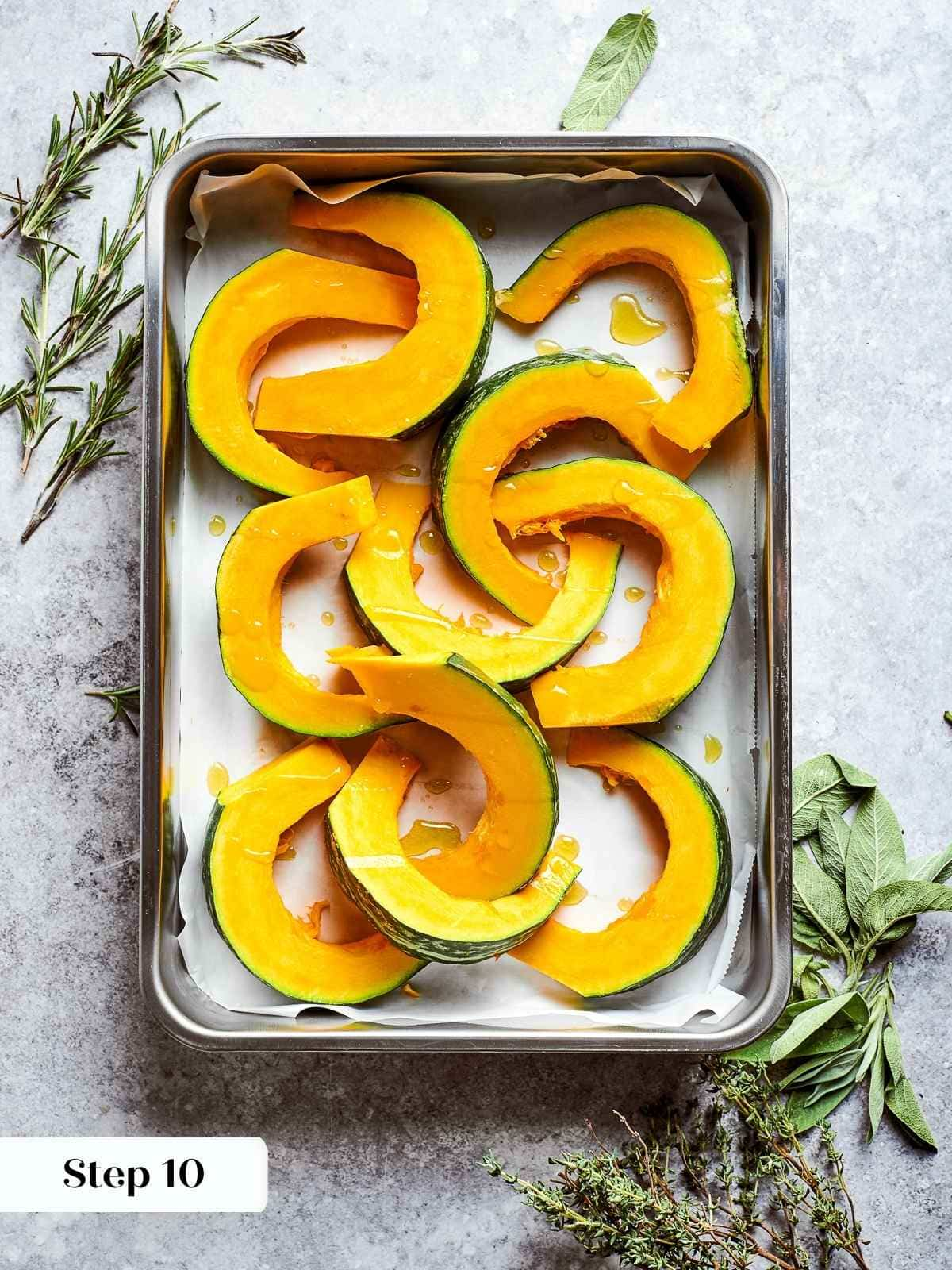
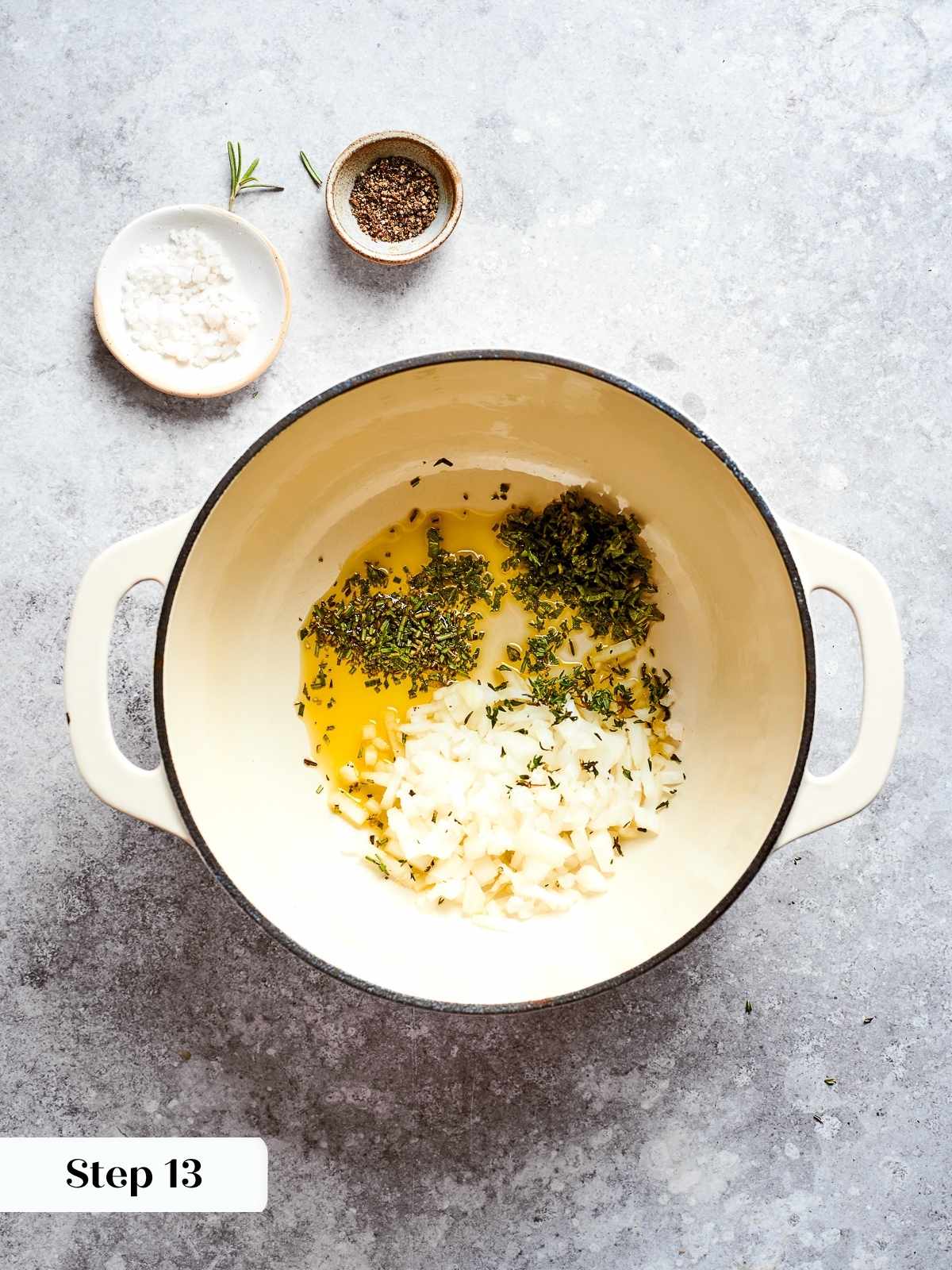
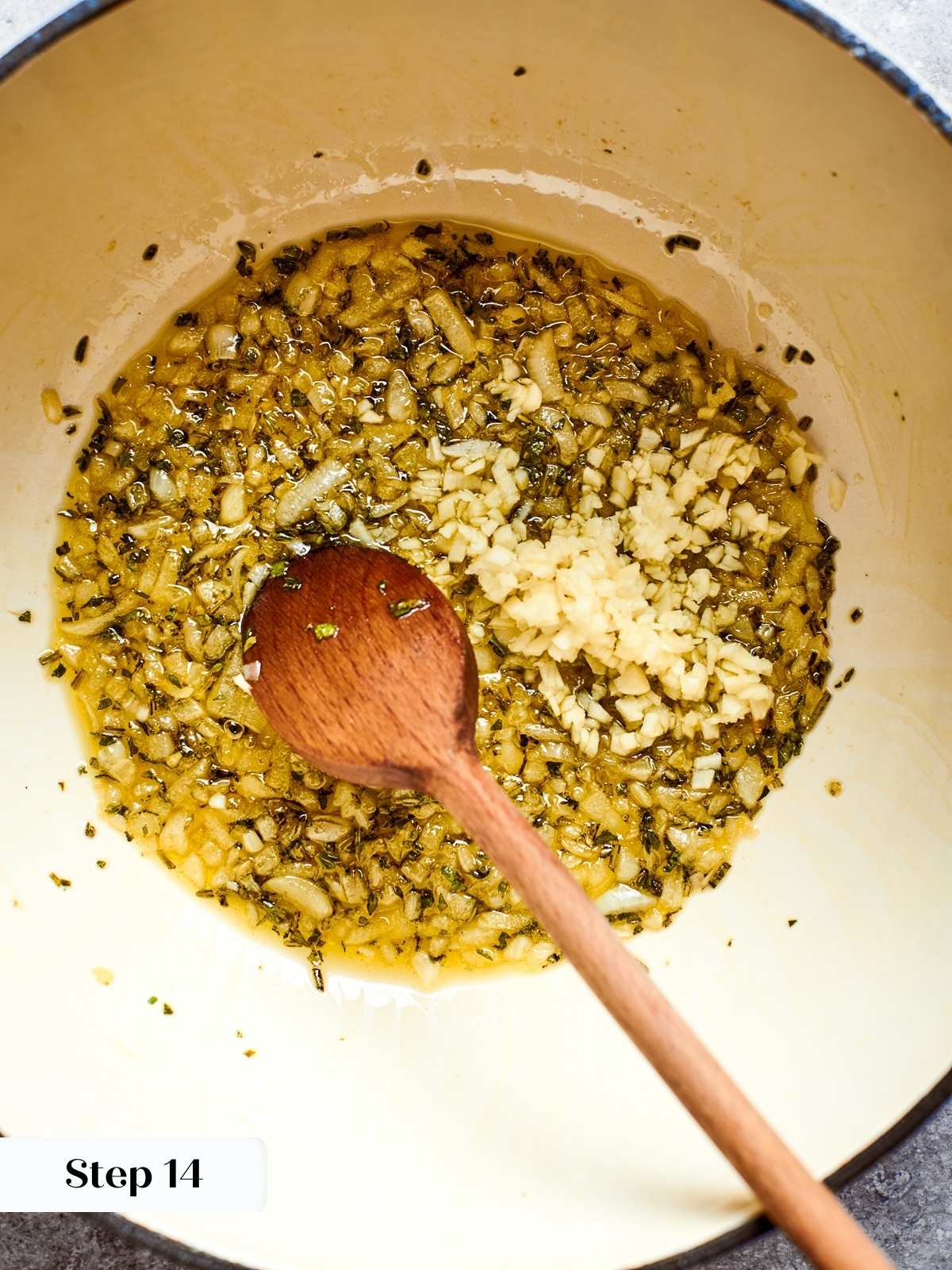

Step 10: Cut into pieces. Working one half of the squash at a time, cut strips about 2 inches wide. Then cut each of those strips into 2 inch pieces. This is approximate. It really doesn’t matter, you just want them to be of a similar size. Repeat with the other half, if you have one (photo 3)!
Step 11: Arrange on a baking sheet. Place all the pieces skin side down (cut side face up!) on a parchment paper lined baking sheet. They can all be crammed together; don’t worry about it. Sprinkle with a little kosher salt and cover with another piece of parchment paper and then a large piece of aluminum foil. Seal the edges down around the squash by curling the foil around the rim of the baking pan.
You can also do this in a large roasting pan or baking dish, depending on how much squash you are cooking and your personal pan selection.
Step 12: Bake until tender. Bake in a preheated oven until the squash is soft and can be pierced easily with a cake tester or pairing knife. This typically takes me around 25 minutes. Remove from the oven and remove parchment and foil from the top.
How to Make Roasted Squash Soup:
Use a Dutch oven or thick-bottomed skillet. Heat olive oil over medium heat until it is hot but not smoking.
Step 13: Sweat the aromatics. In a medium sauce pot add 2 tablespoons olive oil, the onion and herbs. Turn the heat to medium-low and sweat the herbs and onion until almost translucent (photo 4).
Sweating is the term for cooking aromatics enough to release their moisture but not enough to brown them.
Step 14: Add the minced garlic to the pot. If the onions stick even on low heat, add a little more olive oil. Continue to sweat until the onions are transparent (photo 5).
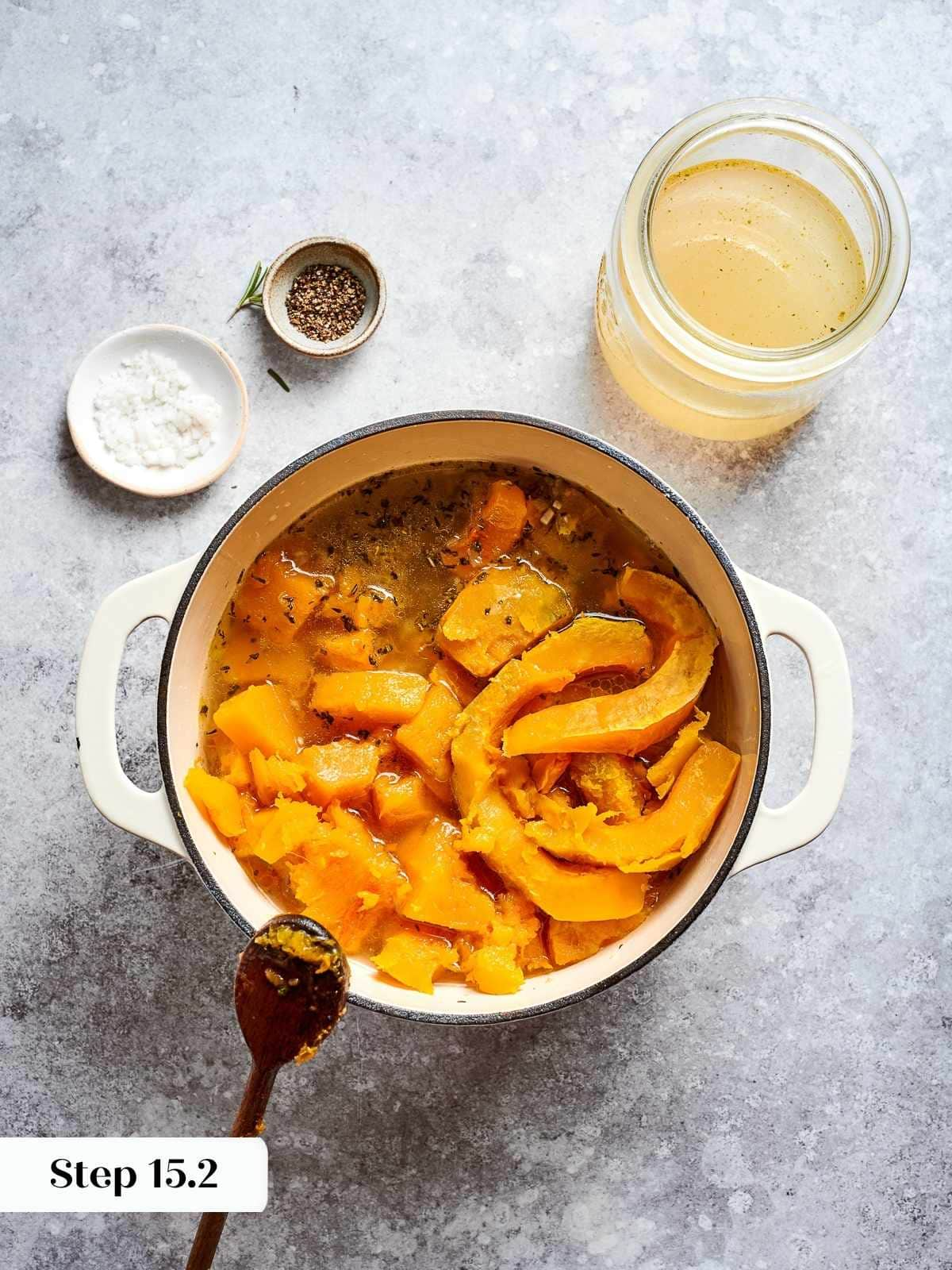
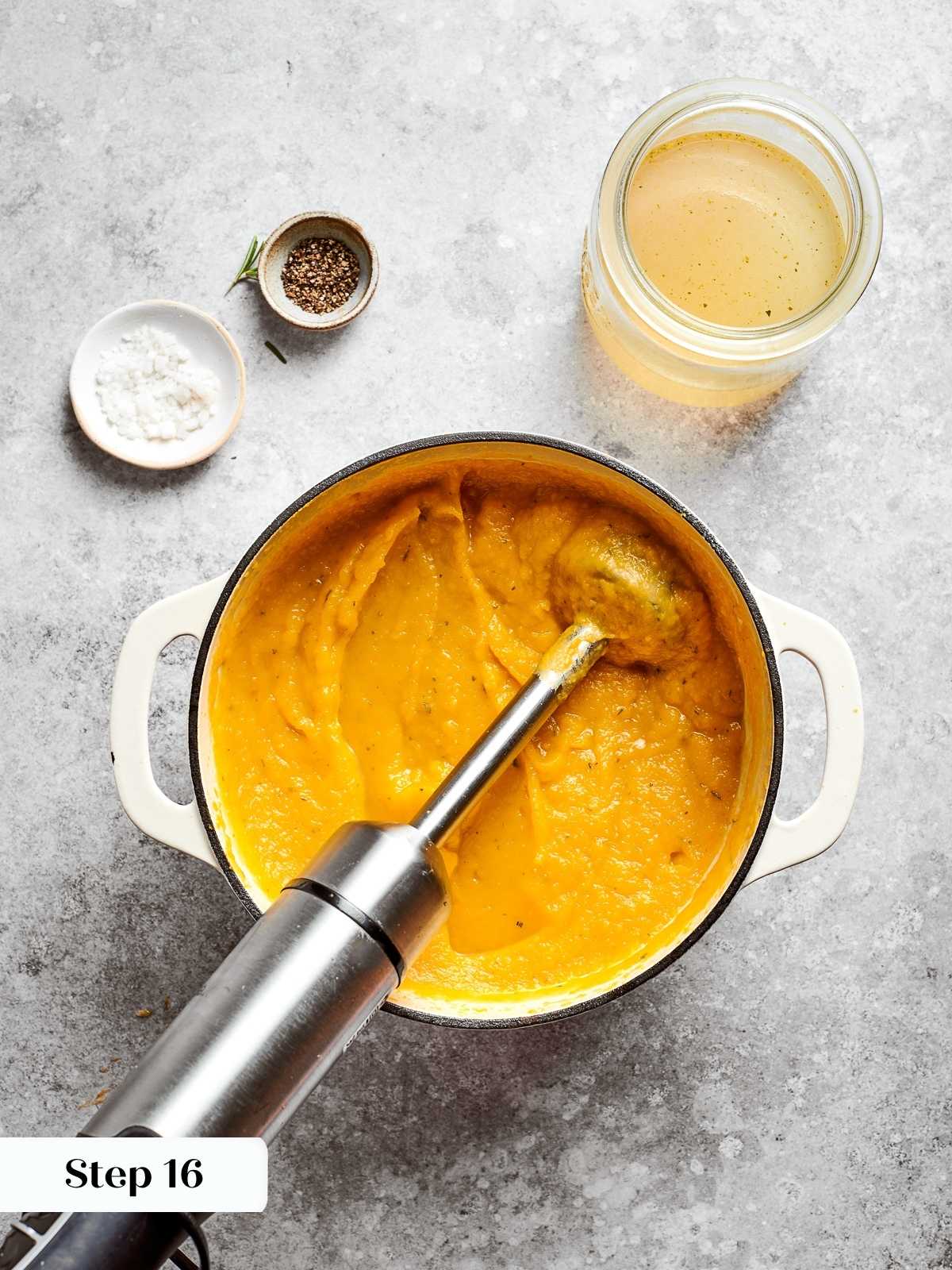
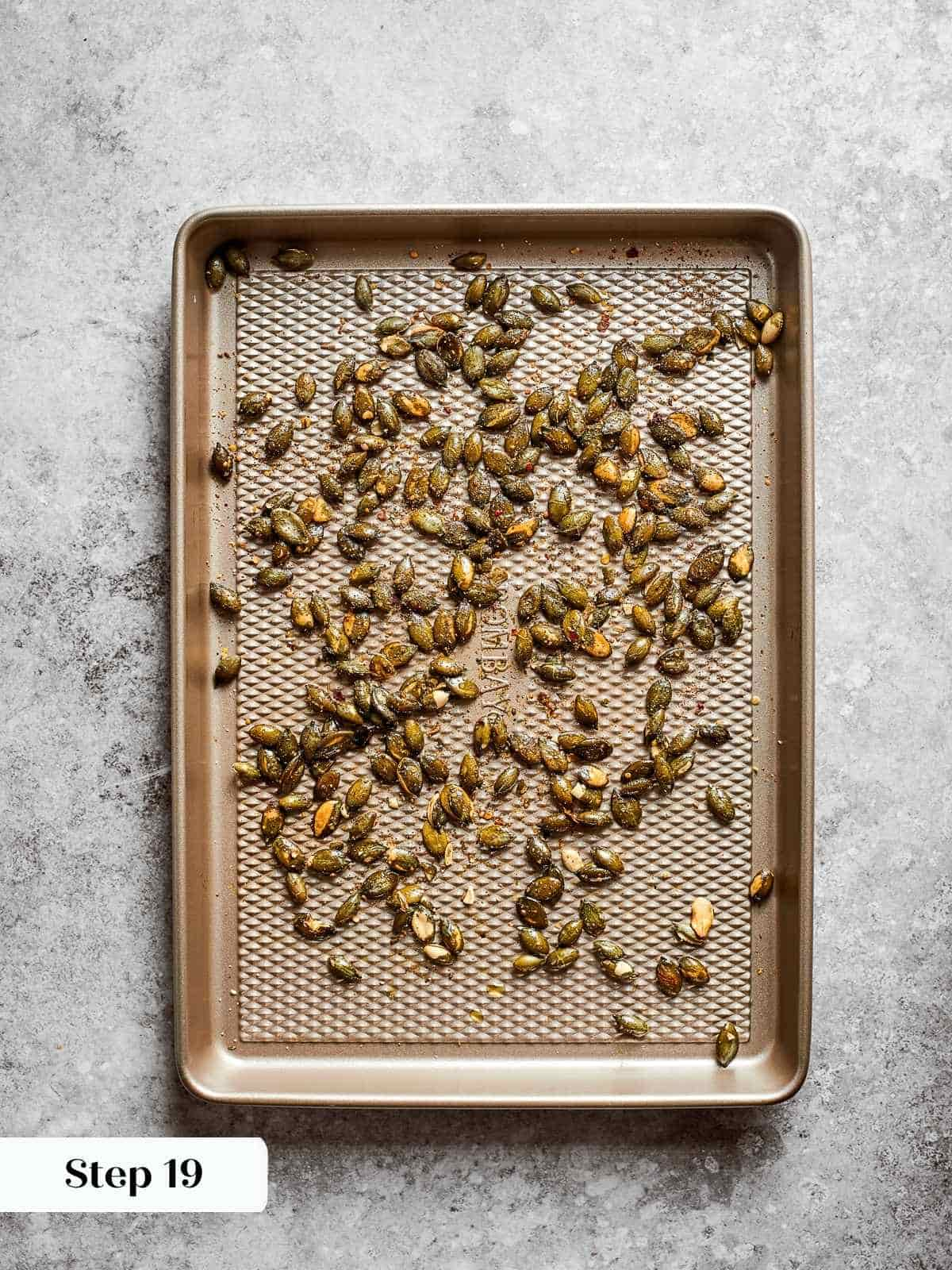
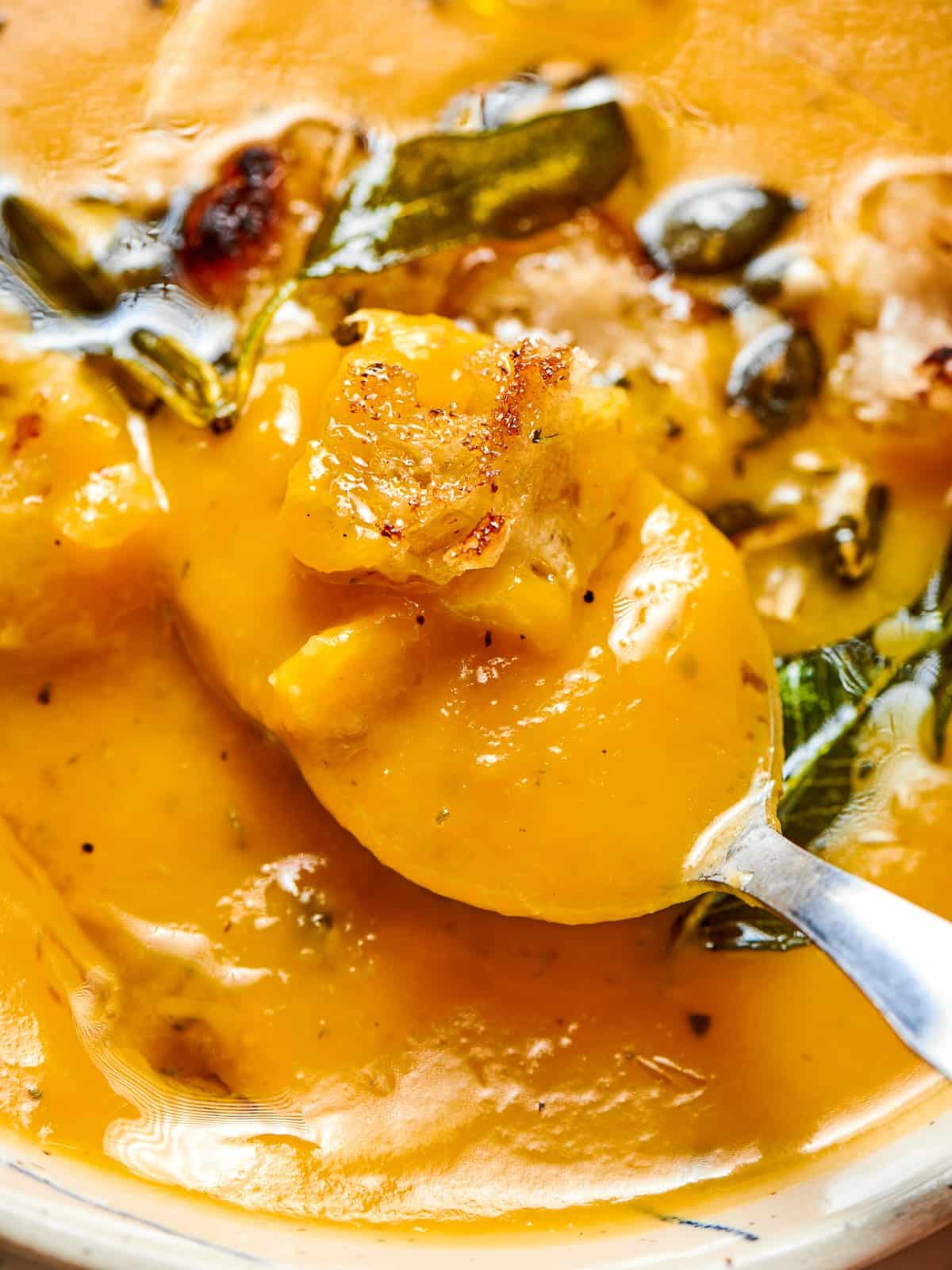
Step 15: Add the squash & half of the stock. Simmer over medium-low to allow the squash to break down into the stock (photos 6 & 7).
Step 16: Blend the soup. Using an immersion blender, blend the soup while still in the pot, adding a little stock at a time until the resulting soup is smooth, pourable but viscous, or where you want it (photo 8)!
You can also purée the soup in a traditional blender with the pour spout open to let steam escape. Consider covering the hole with a folded kitchen towel to protect from hot splatters and mess. Depending on the size of your stand blender, you might need to do this in batches, don’t exceed the maximum fill line! You can still loosen with stock as you go.
Step 17: Taste and season. Taste the soup for seasoning and add fresh ground black pepper and kosher salt to taste.
How to make roasted pepitas:
Step 18: Toss and roast the seeds. In a medium bowl, toss the pumpkin seeds with olive oil, salt and spices. Spread onto a baking pan lined with a piece of parchment paper.
Step 19: Stir until golden. Stir or toss the seeds frequently either while roasting in the oven or pan. Once they look matte (no longer shiny) and have started to turn a golden brown, remove them to cool on the baking sheet (photo 9).
Step 20: Serve in bowls with pepitas and/or croutons sprinkled on top (photo 10).
Chef Lindsey’s Recipe Tip
It is not possible to scoop the soft flesh from the skin of a kabocha like butternut or pumpkin. You will need to scrape off the flesh from each piece individually where the color transitions from orange to green. Don’t stress too much about removing all of the skin or the area in between. It won’t make one bit of difference!
Recipe FAQs
This soup is absolutely delicious the next day. Store leftover soup in an airtight container in the refrigerator for 3-5 days. You can freeze this soup as well.
You can reheat individual servings of this soup in the microwave at 30-second intervals until it is heated through.
Cool the soup completely, transfer it to a freezer-safe container, and freeze for up to 3 months. Thaw overnight in the fridge before reheating.

Recommended Squash Recipes
Easy Side Dish Recipes
Roasted Spiced Butternut Squash
Date Night
Vegan Chili
Easy Side Dish Recipes
Baked Acorn Squash Halves
Winter Dinner Recipes
Twice Baked Spaghetti Squash
If you tried this recipe and loved it please leave a 🌟 star rating and let me know how it goes in the comments below. I love hearing from you; your comments make my day!


Squash Soup
Ingredients
- 3-4 cups roasted butternut squash
- ½ roasted kabocha squash or Blue Hubbard
- 4 cups vegetable stock 32 ounces
- 2 tablespoons fresh rosemary finely minced
- 1-2 tablespoons fresh sage
- 1 tablespoon fresh thyme picked
- 1 small onion small dice (finely chopped)
- 1 tablespoon minced garlic
- 2 tablespoons olive oil
- kosher salt to taste
- black pepper to taste
For the spiced pepitas:
- ½ cup raw pumpkin seeds pepitas
- 1 teaspoon olive oil
- ½ teaspoon smoked paprika
- ¼ teaspoon ground cumin
- ¼ teaspoon cayenne pepper optional, for heat
- ½ teaspoon brown sugar
- ¼ teaspoon kosher salt
Instructions
How to roast butternut squash for soup:
- Preheat the oven to 350°F.
- Cut the top and bottom off the butternut squash with a large chef’s knife. Stand the squash upright on the bottom – you just cut a nice flat surface, which will make a solid base to slice the squash in half. Use the chef’s knife to cut the squash in half lengthwise, pushing down from the top of the knife, keeping your fingers clear of the blade!
- Scoop out the seeds and either throw them out or set them aside to clean and roast.
- Line a baking sheet with a piece of parchment paper and place the squash cut side up on the baking pan. Drizzle with olive oil and sprinkle with kosher salt. Flip them over, cut side down. Poke some holes using a fork or the tip of your knife (carefully!) up and down the length of the squash.
- Place it in the oven and bake until they are soft when pressed with your finger or provide no resistance with a paring knife. The roasting time will vary greatly by the size of your squash! Expect anywhere from 25 – 40 minutes.
- Scoop all the soft, roasted butternut squash flesh from the skins and set aside or cool and store in an airtight container in the refrigerator.
How to roast kabocha or Blue Hubbard squash for soup:
- Preheat the oven to 350°F.
- Cut the top and bottom off the kabocha squash with a large chef’s knife. Stand the squash upright on the bottom – you just cut a nice flat surface, which will make a solid base to slice the squash in half. Use the chef’s knife to cut the squash in half lengthwise, pushing down from the top of the knife, keeping your fingers clear of the blade! Kabocha have thick rinds, so this might take some force; you can also pick the whole thing up and bang it down on the cutting board while keeping your fingers clear of the knife blade!
- Scoop out the seeds and either throw them out or set them aside to clean and roast.
- Working one half of the squash at a time, cut strips about 2 inches wide. Then cut each of those strips into 2 inch pieces. This is approximate. It really doesn’t matter, you just want them to be of a similar size. Repeat with the other half, if you have one!
- Place all the pieces skin side down (cut side face up!) on a parchment paper lined baking sheet. They can all be crammed together; don’t worry about it. Sprinkle with a little kosher salt and cover with another piece of parchment paper and then a large piece of aluminum foil. Seal the edges down around the squash by curling the foil around the rim of the baking pan.
- Bake in a preheated oven until the squash is soft and can be pierced easily with a cake tester or pairing knife. This typically takes me around 25 minutes. Remove from the oven and remove parchment and foil from the top.
How to Make Roasted Squash Soup:
- In a medium sauce pot add 2 tablespoons olive oil, the onion and herbs. Turn the heat to medium-low and sweat the herbs and onion until almost translucent.
- Add the minced garlic to the pot. If the onions stick even on low heat, add a little more olive oil. Continue to sweat until the onions are transparent.
- Add the squash & half of the stock. Simmer over medium-low to allow the squash to break down into the stock.
- Using an immersion blender, blend the soup while still in the pot, adding a little stock at a time until the resulting soup is smooth, pourable but viscous, or where you want it!
- Taste the soup for seasoning and add fresh ground black pepper and kosher salt to taste.
How to make the roasted pepitas:
- In a medium bowl, toss the pumpkin seeds with olive oil, salt and spices. Spread onto a baking pan lined with a piece of parchment paper.
- Stir or toss the seeds frequently either while roasting in the oven or pan. Once they look matte (no longer shiny) and have started to turn a golden brown, remove them to cool on the baking sheet.
- Serve in bowls with pepitas and/or croutons sprinkled on top.
Notes
Nutrition
Before You Go
I hope you enjoyed this cozy weeknight recipe. Check out our other delicious soup recipes!
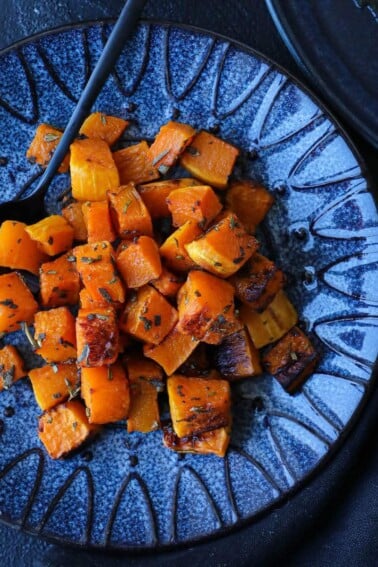
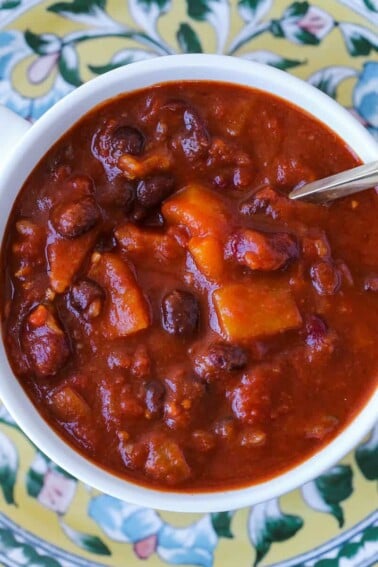
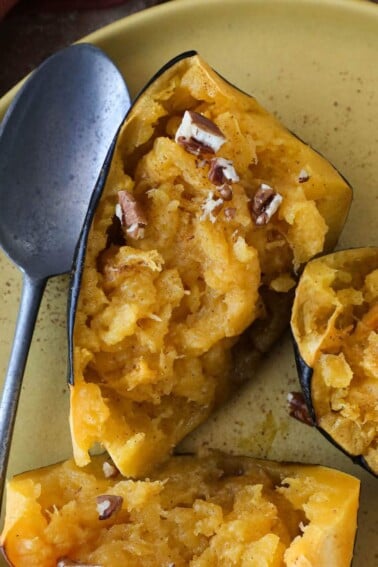
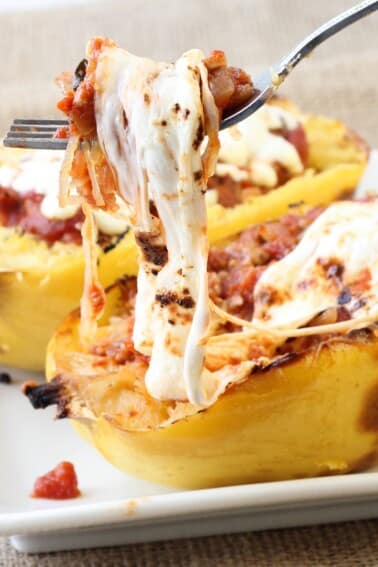
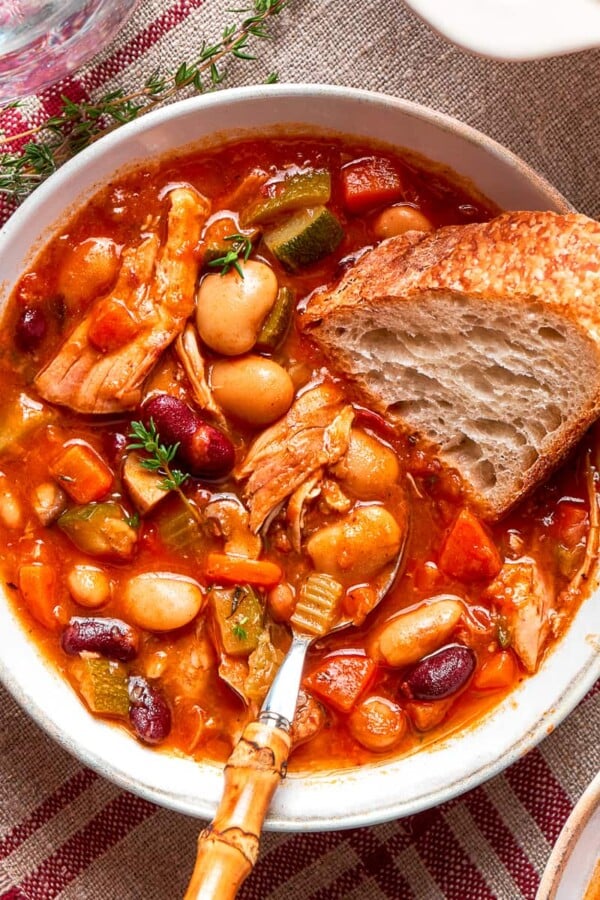
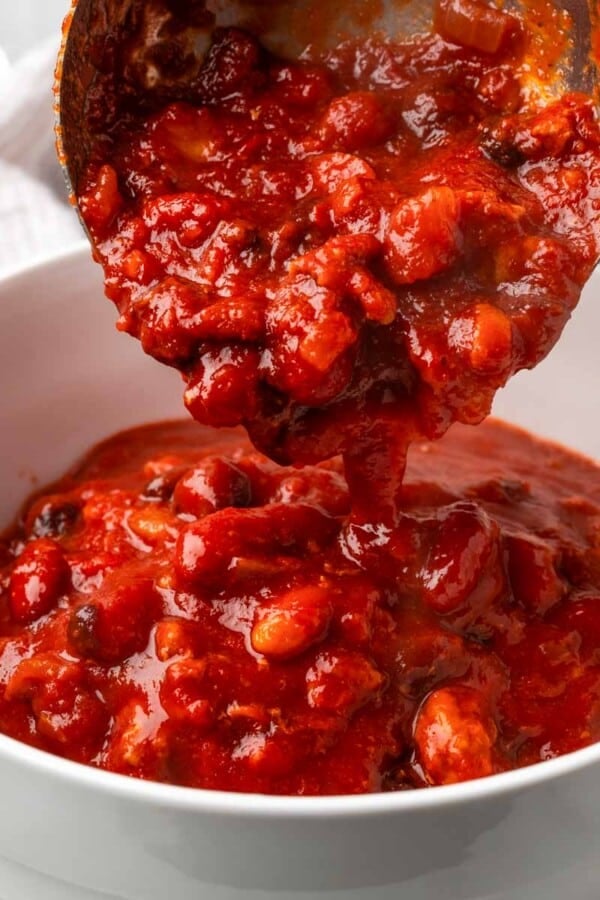
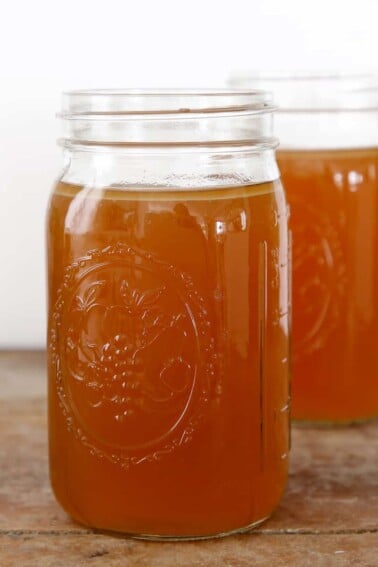
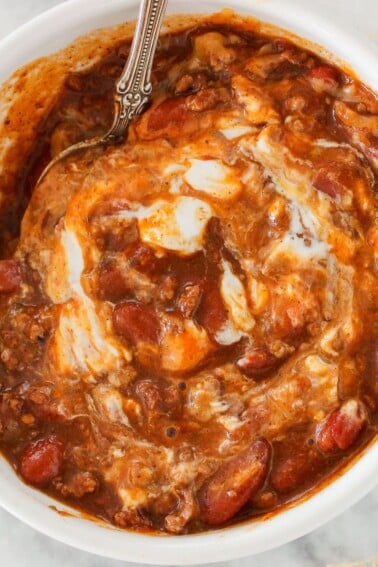









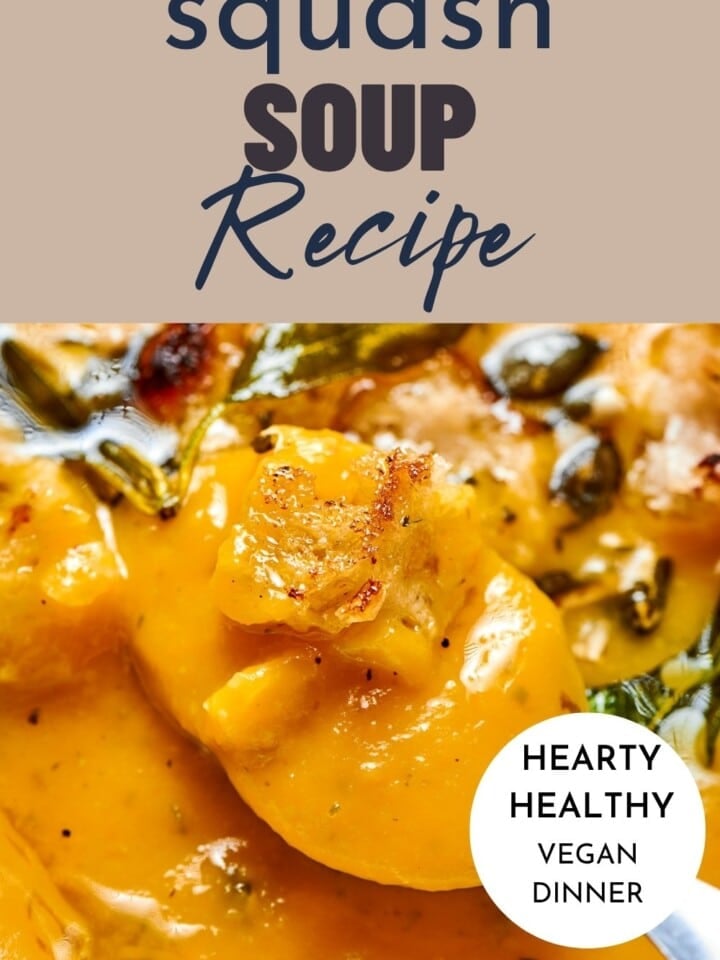


This soup was incredible! The note about fresh produce was so helpful because the squashes near me are almost the size of housecats, so knowing how to adjust the roasting time really made a difference. I couldn’t believe how creamy this turned out for a vegan recipe. Definitely adding this one to my fall rotation!